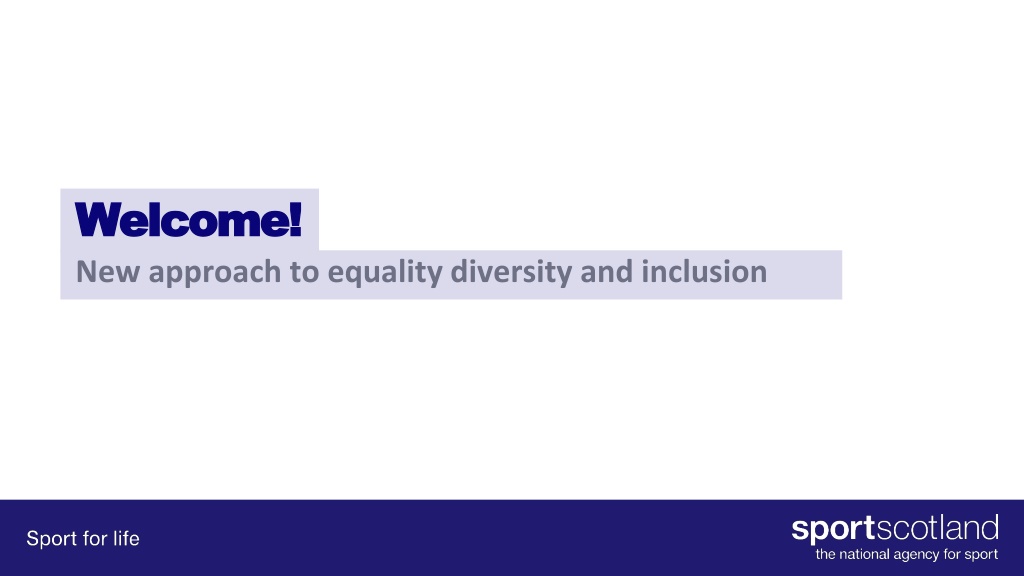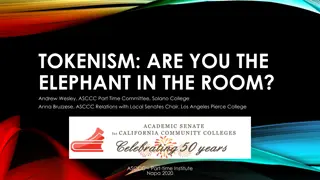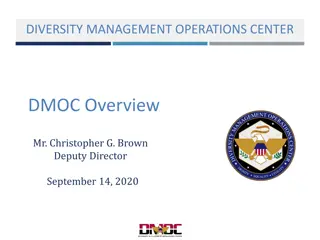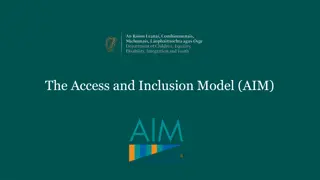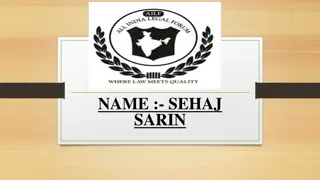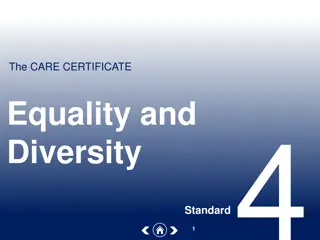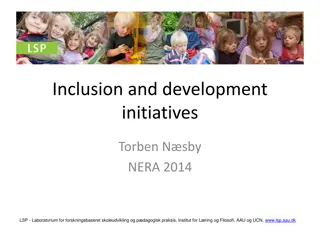Transforming Equality, Diversity, and Inclusion in Sports
Embracing a new approach to diversity and inclusion in the sporting system in Scotland, this content delves into the importance of inclusive design, working together effectively, and addressing structural inequalities. It highlights the challenges around visibility, representation, and decision-making in sports, emphasizing the need for a more inclusive and representative approach.
Download Presentation

Please find below an Image/Link to download the presentation.
The content on the website is provided AS IS for your information and personal use only. It may not be sold, licensed, or shared on other websites without obtaining consent from the author. Download presentation by click this link. If you encounter any issues during the download, it is possible that the publisher has removed the file from their server.
E N D
Presentation Transcript
Welcome! Welcome! New approach to equality diversity and inclusion
Today Today Our new approach to Equality, Diversity and Inclusion How did we get here? Be an inclusive designer
Working together Working together This is a learning space: o Talk in whatever words you currently know. It doesn t matter if you use awkward or dated language. The important thing is that you start to explore openly what s on your mind as regards the topic. o Listen to understand, not to respond o Monitor your airtime, let people finish their thoughts. o It s ok to step off the call or turn the camera off o Maintain confidentiality
Sport for Life Sport for Life
Inclusive by design Inclusion shouldn t be an afterthought, or a bolt-on.
How did we get here? How did we get here? more needs to be done to confirm how the commitment to inclusion underpins everything we do is understood and brought to life by staff and partners in the sporting system in Scotland. Equality and Sport Research 2020
How did we get here? How did we get here? 80% 54% The majority of adults had take part in physical activity and sport. All adults, excluding walking Source: Scottish Household Survey
Structural inequalities Structural inequalities We asked Who are the 54%? Are they representative of the Scottish population? We found Our protected characteristics currently determine: - how likely it is we will take part in sport - our experiences of taking part
How did we get here? How did we get here? Visibility and representation I don't see or hear about people like me taking part. I feel excluded because there is a dominant group in sport it feels like their space, not mine. People make assumptions about me based on stereotypes. Design and decisions I don't have a voice in how sport is run. My needs aren't reflected. I'm not asked about what matters to me. I'm not involved in decisions. I don't have any connection with decision makers. How I feel It's daunting to start or to get back in to sport. I'm anxious. I don't feel safe. I don't feel confident. I don't have the motivation. I've had bad experiences. I'm nervous about new people and experiences. The offer The offer isn't right for me. Cost and transport are barriers. It is not offered in places I would go to or at the times I am free. I'm concerned about amenities like changing rooms and toilets.
Structural inequalities Structural inequalities It tells us Something about the way we have designed our system, means every year the same inequalities are reproduced. How does this happen?
Structural inequalities Structural inequalities No matter how you design anything, consciously or unconsciously, you create an outcome. Your decisions influence and shape the way our system is designed. We are all designers in this system.
What do you design? What do you design? Design is a structured, creative, problem-solving process. (5 mins) In pairs Connect up. What have you helped design? Things in our system that I ve designed include
Design is a structured, creative, problem-solving process. No matter how you design anything, consciously or unconsciously, you create an outcome. Your decisions influence and shape the way our system is designed. We are all designers in this system. Lets explore how design decisions can exclude
In groups.. In groups.. Groups of 4-5 (15 mins) Lets explore how design decisions can exclude. What do these images represent for you? Do they recall a story?
When an Architectural Gem Is Not Accessible to All - The New York Times (nytimes.com)
Please complete: Please complete: Mother/Father: Parents/guardians: Husband/Wife: Spouse/partners: Marital status: Relationship status: My new favourite form. Really. - Government Digital Service (blog.gov.uk) Focus on Forms and Policy: Creating an Inclusive Environment for LGBT Patients
How design can exclude How design can exclude Share something that stood out for you!
Inclusive design Inclusive design Inclusive design is the practice of intentionally including the needs of people who experience exclusion in many aspects of their daily lives throughout our design process.
Designing with empathy Designing with empathy "Empathy is at the heart of design. Without the understanding of what others see, feel, and experience, design is a pointless task. Tim Brown IDEO
Design a purse or wallet Design a purse or wallet You ll need: Paper and pen Your current purse/wallet
Agree roles: Task master Designer User You will be supporting the others to complete this task. You ll be part of the design process. You will lead the design process. You share your experiences and needs with the designer. Guide them through the instructions and keep the group to time. You ll propose an initial solution. You reflect on your experience of being involved. You ll involve the user in the process to generate new ideas. Be an observer and help the group reflect on the process.
3 minutes Make a rough sketch of a wallet or purse. Highlight some features and needs your solution addresses. 5 minutes Interview the user Learn about how they use their wallet or purse. Your job is to design something meaningful for this person, so dig in - find out what is important for them. Ask the person to take it out and show you the contents. What are some of the emotionally charged objects pictures of children or pets? What stands out? Invite them to tell you stories about the things they hold. Ask why - a lot! 5 minutes Get another piece of paper and come up with new solutions for your user more than one if you want. They don t need to be wallets! Maybe the interview will trigger something else. Don t worry about being sensible, just explore and respond to your user.
Inclusive design Inclusive design Inclusive design is the practice of intentionally including the needs of people who experience exclusion in many aspects of their daily lives throughout our design process.
Discussion Discussion Discuss the experience What do you notice? How was the experience the second time compared with the first? How did it feel to connect with the user?
Designing with empathy Designing with empathy What do you notice? Were your ideas different the second time around? In what way? more interesting, funny, or even innovative? Was it easier to develop ideas? Do the second set of ideas feel like they are more tailored to meet the needs of the person you talked to? If so . you ve experienced the power of empathy in action.
Designing inclusivelyfirst steps Designing inclusively first steps Person-centred: Involve and put people at the centre of your design process. Understand exclusion: Listen to the experiences of people you might be unintentionally excluding. Leverage diversity: Exclusion happens when we solve problems using our own biases. Involve people with different perspectives. Make sure to include the people that have difficulty using your current approaches. Start small and simple: Test and refine your ideas to make sure they meet people's needs.
Launch package Launch package A toolbox to help you learn about the basics of equality, diversity and inclusion in sport, and progress to learning about inclusive design. Livenow! EDI toolbox sportscotland website about us 1 hour workshops and elearning on a range of EDI fundamentals July EDI bitesize A space for conversations and chance to meet inclusive designers and people with a wide range of lived experience. July Thought leaders events
Next steps Next steps We can learn from others. You are joining a community of organisations who are bringing design thinking to the problem of inequality and exclusion.
